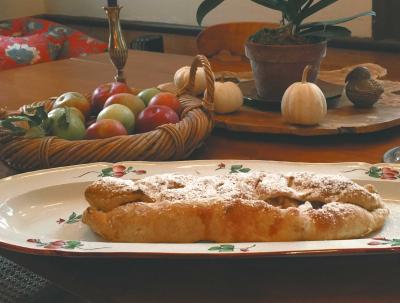Seasons by the Sea: How ’Bout Them Apples!

Apples are the Everyman of fruit. They are inexpensive, available year round, and readily accessible. Even airports and gas stations sell apples. Besides being delicious on their own, they are exceptionally versatile. They can be used in savory recipes as well as sweet. They can be pressed for cider, dried for a snack, made into chutneys, sauces, and butters, baked into pies and tarts, folded into coffeecakes and muffins, incorporated into soups, baked whole, and more.
You could be lazy and boring and go to the supermarket and purchase those safe choices, Red Delicious and Granny Smith, but you shouldn’t. I’m sorry if it sounds like I’m trying to shame you into trying more varieties, but I am, and you should.
First of all, those perfect, shiny specimens have most likely traveled across the country and spent a good part of their life in cold storage, in addition to having been coated with some nasty preservative that isn’t so easy to get off. Instead, why not make a pilgrimage to the Milk Pail in Water Mill or Hank’s Pumpkintown in Water Mill to pick your own with your kids? Better yet, take a field trip to the North Fork and explore the different farm stands. Some of them even have dwarf trees, enabling children to reach the low-hanging fruit. Best of all, unlike the backbreaking work and lower yield of berry picking, you’ve got quite a few pounds of apples within minutes.
I am fortunate enough to have some friends in Sag Harbor who have about 12 apple trees on their property, and I have carte blanche to pick as many as I want. That is, whatever the deer don’t get first. Some are McIntosh, some are a mysterious, small green variety. The Milk Pail is another favorite fall destination because the owners are constantly experimenting with new varieties. Their cider is the best, the donuts are out of this world, and I’ve said it before (begrudgingly), that their streusel-topped apple pie is better than mine. Grrrrr. Kidding.
On the savory side, apples just so happen to go beautifully with certain fall dishes, such as roast pork and grilled duck breast. They can sweeten a butternut squash soup. One of my favorite cheats is combining applesauce with a good amount of horseradish. Served alongside mashed potatoes and the aforementioned roast pork, it provides a sweet-spicy side dish. This is also a good time of year for heartier salads suchas apples with shaved fennel, toasted walnuts, and endive with some crumbled blue cheese. An apple can even stand alone as a dessert, cored and filled with nuts, some cinnamon, a dab of butter, and baked.
Apples, Malus pumila, are one of the first fruits to be cultivated and are related to roses. There are over 7,000 named varieties and they are grown all over Europe, North America, and the temperate regions of both the northern and southern hemispheres. In the United Kingdom, folks commonly categorize their apples into two types: eating and cooking. The cooking apples are green and tart and fall apart when cooked. The eating apples are red and crisp and sweet. In America, not surprisingly, preferences are based on appearance: a perfect red apple is more popular than a mottled, misshapen, funny looking one.
According to Harold McGee’s “On Food and Cooking,” different varieties of apples have distinctly different flavors. Gravenstein and Granny Smith are described as being “simple and refreshing,” Northern Spys have a strawberry-raspberry taste, McIntoshes are “winey,” Pippins are “flowery,” Golden Delicious, Fujis, and Gala apples have a hint of honey, and others have traces of tarragon, pineapple, and nutmeg flavors. No wonder they are so versatile in so many forms!
Apples help lower cholesterol, they fill you up with fiber, can aid in decreasing diabetic risk, boost brain power, and contain triterpenoids, which fight against liver, colon, and breast cancers.
When buying or picking apples, try to find unbruised, fragrant, firm ones. Check them carefully before you place in the produce bin of your refrigerator because the old adage “one bad apple spoils the barrel” is true. The most common suggestions for storage are that they should last two to three weeks, but I find they last much longer. If they become a bit wrinkly or soft, just cook them. And don’t be intimidated at the prospect of making a pie crust or strudel dough; feel free to cheat and use a store-bought crust or frozen phyllo or puff pastry and proceed from there.
For simpler homemade baked desserts with pastry, try making a cobbler or pandowdy, which utilizes an easy-to-assemble biscuit dough. Cinnamon and nutmeg are the usual spices to combine with apples, but it is also worth trying lemon zest and vanilla extract, which really let the apple flavor shine through. A tablespoon or two of Calvados (French apple brandy) also really bumps up the flavor.
From savory to sweet, simple to complex, there are so many ways to cook and eat apples.
Applesauce
You can leave out the butter, but it does give it a nice, rich consistency.
2 lbs. tart apples, such as Granny Smith, peeled, cored, and chopped
1/4 cup or more to taste, granulated sugar
Juice of 1 lemon and 1/2 tsp. of grated zest
Pinch of salt
Pinch of cinnamon, if desired4
Tbsp. butter, cut into pieces
Place chopped apples in heavy, non-reactive saucepan with the next four ingredients. Add about a half to a cup of water and cook over medium heat, stirring or shaking the pan occasionally, until apples have broken down and are tender, about 15 minutes. Taste and add more sugar if desired.
Take pan off the heat and stir in butter. You can keep the applesauce chunky or puree it in the blender for smoother sauce. If you add butter, it is best to serve warm. This will keep in the refrigerator for about four days.
